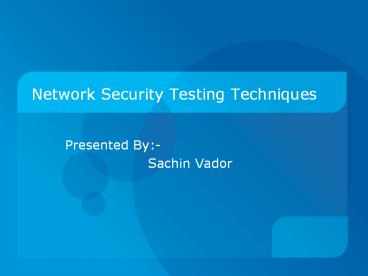Network Security Testing Techniques - PowerPoint PPT Presentation
Title:
Network Security Testing Techniques
Description:
... for Penetration Testing. Network ... Penetration Testing ... Points of contact for the penetration testing team, the targeted systems, and the networks ... – PowerPoint PPT presentation
Number of Views:729
Avg rating:3.0/5.0
Title: Network Security Testing Techniques
1
Network Security Testing Techniques
- Presented By-
- Sachin Vador
2
System Development Life Cycle
3
System Development Life Cycle
- 1. Initiation the system is described in terms
of its purpose, mission, and configuration. - 2. Development and Acquisition the system is
possibly contracted and constructed according to
documented procedures and requirements. - 3. Implementation and Installation the system
is installed and integrated with other
applications, usually on a network. - 4. Operational and Maintenance the system is
operated and maintained according to its mission
requirements. - 5. Disposal the systems lifecycle is complete
and it is deactivated and removed from the
network and active use.
4
When is the Network Security Testing done?
- It is done after system has been developed,
installed and integrated during Implementation
and Operational stages.
5
Tools and Techniques for Network Security
- Network Scanning
- Vulnerability Scanning
- Password Cracking
- Log Reviews
- War Dialing
- Wireless LAN Testing (War Driving)
- Penetration Testing
6
Network Scanning
- Scan for connected hosts
- Scan for services running on the host
- Scan for which applications are running those
services - How Scanning takes place?
- Ping the hosts using ICMP ECHO and Reply. Look
for open TCP/UDP ports. - Operating system fingerprinting.
- Not reliable as firewalls can be configured to
camouflage the operating system.
7
Network Scanning
- Vulnerabilities of IIS different from Apache.
- Listen on the remote port.
- Banner Grabbing.
- Need human to interpret the results.
- Preparation for Penetration Testing.
8
Network Scanning Results
- Investigate and disconnect unauthorized hosts
- Disable or remove unnecessary and vulnerable
services - Modify vulnerable hosts to restrict access to
vulnerable services to a limited number of
required hosts (e.g., host level firewall or TCP
wrappers), and - Modify enterprise firewalls to restrict outside
access to known vulnerable services.
9
Vulnerability Scanning
- Takes Network Scanning 1 step ahead.
- Maintains database of vulnerabilities in
operating systems. - They generate more traffic that port scanners.
- Network based Scanners.
- Host based Scanners.
10
Log Reviews
- Dynamic picture of system activities.
- Conformance with the security policies.
- IDS sensors placed behind firewall.
- Change Firewall Policies.
11
War Dialing
- Unauthorized modems.
- Dialing software can dial hundreds of numbers in
short time - Block the inbound calls to the identified number
if it is not possible to remove them
12
War Driving
- Wireless Default Configuration is insecure.
- Drive Test
- Just need wireless network card and testing tools
- Frequency of testing
13
Penetration Testing
- It is a method of getting into the system by
using the techniques used by the attacker. - Specific IP addresses/ranges to be tested
- Any restricted hosts (i.e., hosts, systems,
subnets, not to be tested) - A list of acceptable testing techniques (e.g.
social engineering, DoS, etc.) and tools
(password crackers, network sniffers, etc.) - Times when testing is to be conducted (e.g.,
during business hours, after business hours,
etc.) - Identification of a finite period for testing
- IP addresses of the machines from which
penetration testing will be conducted so that
administrators can differentiate the legitimate
penetration testing attacks from actual malicious
attacks - Points of contact for the penetration testing
team, the targeted systems, and the networks - Measures to prevent law enforcement being called
with false alarms (created by the testing) - Handling of information collected by penetration
testing team.
14
Penetration Testing
- Blue Teaming
- Red Teaming
15
Phases of Penetration Testing
16
Phases of Penetration Testing
- Planning Phase
- Goals are set. Permission is taken. No
testing. - Discovery Phase
- Testing starts. Port scanning is used to
identify the vulnerabilities. - Executing the attack
- Exploit the vulnerabilities.
17
Conclusion
- Acceptable use guidelines (e.g., what is
acceptable use of organization computing and
network resources) - Roles and responsibilities (for users,
administrators, management) - Authentication (e.g., passwords, biometrics)
- Availability of resources (redundancy, recovery,
backups) - Compliance (infractions, consequences and
penalties).
18
Questions ?































